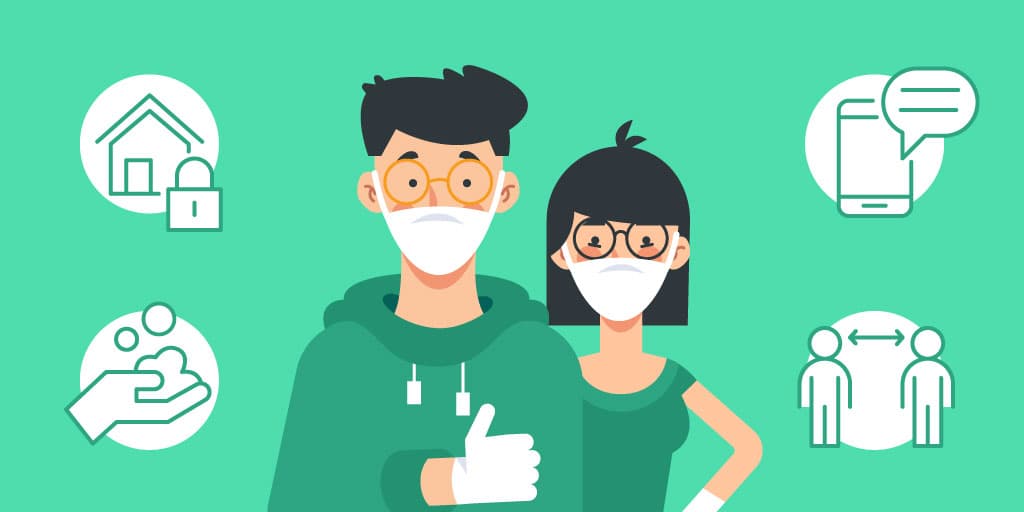Panic is never a good answer to national crises, but it’s inevitable when there’s zero transparency and information. People turn to fake news because those offer quick solutions.
Since the coronavirus outbreak, the health and safety advice from the World Health Organization has remained unchanged:
practice good hand-washing hygiene
maintain social distancing
avoid touching eyes, nose or mouth
For businesses that can afford to allow remote working, the situation is clear. But what about businesses that cannot do the same: government offices, healthcare facilities, pharmacies, groceries and more?
If your business chose to stay open, you are obligated to keep your workplaces, employees and customers safe. Here are the essential tips on safe queue management during quarantine.
Safety tip #1: Keep your facility clean
Businesses, especially those pertaining to the food industry, should maintain clean and sanitized facilities. All contact surfaces need to be disinfected regularly to prevent potential infection.
For queue management systems with physical sign-in stations, this means wiping down the screen. Use alcohol-based hand sanitizers (at least 60% alcohol).
Safety tip #2: Minimize physical interactions
Public health experts, including a spokeswoman for WHO’s COVID-19 team, indicate that there’s no evidence that cash is transmitting the coronavirus.
Still, customer service agents accepting anything during the pandemic should be wearing disposable gloves, have tissues nearby, and respect the social distance regulations.

The safe distance to counteract the spread is six feet (two meters)
Safety tip #2: Reduce crowding in lobbies and waiting areas
Likewise, customers should be able to have enough room as to not be in physical proximity to one another. Otherwise, having people locked in one place is a major health hazard.
You need to limit the number of people who can visit and stay at your location at one time.
Safety tip #3: Enable remote queuing
One of the ways to manage queues effectively in the light of COVID-19 is to allow customers to queue up digitally and leave their contacts. This way, they can wait in the safety of their homes or cars.
For instance, Qminder offers Visit Planner — a special webpage that allows to sign in remotely and give your phone number so that you’d be contacted when it’s your turn.
If you use or plan to use another queue management system, inquire about their remote queuing possibilities. It is not the time to play the situation by ear.
The point of virtual queuing is to, again, empty the lobbies as much as possible.
Safety tip #4: Help practice social distancing
In response to COVID-19, all people are required to reduce social interactions, minimize close contact, and keep the distance of at least two meters away from others.
Businesses that are still open can help their customers practice social distancing through the use of spacing measures. Placing floor markers is an easy way to show visitors how far apart they need to stand from one another.
For example, this is how some Danish and German supermarkets help their customers maintain a safe distance from one another.

No need to worry about the design. A simple duct tape X is all it takes.
Safety tip #5: Raise staff awareness
Businesses should make sure that their staff fully understands the present COVID-19 situation and the ways to minimize risks:
Social distancing: ensure next to no physical contact between employees.
Rigorous hygienic practices: provide the facilities and means to practice good hygiene — washing hands on a regular basis, after each case of coughing, using a toilet, handling waste, etc.
Timely recognition of symptoms: give your employees the tools and confidence to report any signs of illness.
As a business owner or a location manager, you should be the one deciding who is not fit to work so as not to exacerbate the situation.
Safety tip #6: Provide the means for self-sanitation
Employees and visitors who do come to your location need the means to practice good hygiene. Thus, you need to provide hand sanitizers and hand rubs where possible.
Moreover, there need to be wipes to clean the objects frequently interacted with. In general, the touchpoints of your location — such as sign-in kiosks, chairs, stalls and trays — should be cleaned on a regular basis.
Safety tip #7: Err on the side of over-communication
The queue management solutions, like the above-mentioned Visit Planner, are useful not only because they allow the visitor to queue up remotely. The other benefit is that they allow you to gauge the waiting situation without having to be physically present at the location.
With these queuing tools, business owners can share with visitors:
the number of people currently waiting
the average wait time
recommended time(s) to visit
the exact location and contact information
Another tool to take advantage of in these circumstances is SMS messaging. As visitors share their phone numbers with your system, you can communicate important information to them, such as:
the change in working hours
the delay of services
safety guidelines
Thus, SMS notifications allow visitors to leave crowded areas and only arrive at the location when it’s their turn to be served.
You can also ask visitors via SMS chat whether they would like to cancel or reschedule their meeting. If so, your agents can quickly make adjustments to the waitlist, without the need for face-to-face contact.
Having a personal touch while offering touchless service is a tough task. Having safe queues during quarantine is a whole ‘nother level of difficult.
But for now, what we can do is stay safe — for our own sake as well as for the people around us. Let’s tackle our problems one at a time, together.
When everything blows over, there’d be quite a number of lessons — on customer service, employee experience and location management — we would’ve learned almost by accident.






